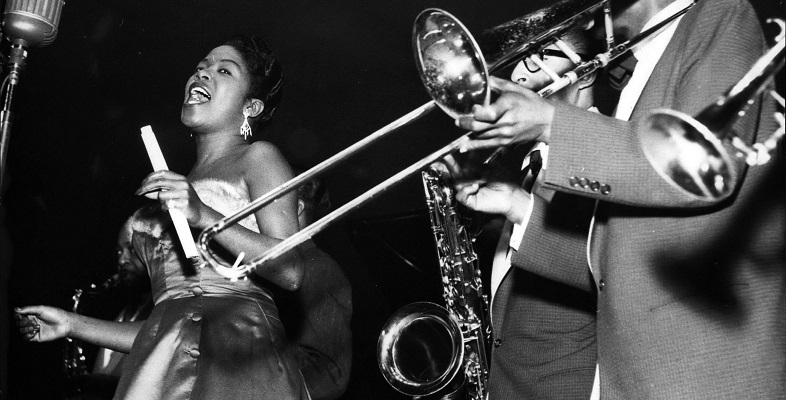7 Form in instrumental jazz
As was evident in Vaughan’s performance of ‘Just One of Those Things’, performers of jazz and popular song sometimes move through a song form such as AABA more than once in a performance.
In the next activity, you’ll listen to another performance of ‘Just One of Those Things’, this time without a vocalist. The performance features pianist Bud Powell and saxophonist Don Byas playing together with bassist Pierre Michelot and drummer Kenny Clarke.
Jazz instrumentalists regularly make use of the possibility of repeating a song’s structure, albeit in a particular way. They begin by performing a familiar version of the song, with the melody presented prominently and in an easily recognisable form. They do the same thing at the end of the piece, sometimes taking a few more liberties there. Musicians refer to this recognisable version of the song – the part that carries something like the original melody – as the head.
In the middle of the piece, the musicians move several times through the song form, maintaining aspects of the harmony and rhythm (you will learn about these musical parameters later in this series of courses) but taking turns improvising new melodies. The repetitions of the song’s form are called choruses.
Activity 8 Listening to an instrumental version of ‘Just One of Those Things’
In Audio 7 [Tip: hold Ctrl and click a link to open it in a new tab. (Hide tip)] you will hear Powell, Byas, Michelot and Clarke playing an instrumental version of ‘Just One of Those Things’. Listen to the performance three or four times while following along with the form in Table 10. Most of the details have been provided but some parts of the table are incomplete. Add the missing information once you have a sense of the unfolding form.
You may find that humming the original melody of the song helps you keep track of the form as you listen to the improvised choruses. However new the improvised melodies, the accompaniment still fits the original melody.
| Section | Form | Track time | Soloist and instrument |
| Introduction | — | 00:00 | |
| Head | AABA | 00:06 | Powell, piano |
| Chorus 1 | AABA | 00:55 | Byas, saxophone |
| Chorus 2 | AABA | 01:45 | Byas, saxophone |
| Chorus 3 | AABA | Powell, piano | |
| Chorus 4 | AABA | 03:24 | Powell, piano |
| Head | AABA | Byas, saxophone |
Comment
Here is the completed table.
| Section | Form | Track time | Soloist |
| Introduction | — | 00:00 | |
| Head | AABA | 00:06 | Powell, piano |
| Chorus 1 | AABA | 00:55 | Byas, saxophone |
| Chorus 2 | AABA | 01:45 | Byas, saxophone |
| Chorus 3 | AABA | 02:35 | Powell, piano |
| Chorus 4 | AABA | 03:23 | Powell, piano |
| Head | AABA | 04:12 | Byas, saxophone |
You may have noticed that the repetition of the head at the end of the performance is not altogether straightforward. Byas plays the main melody for most of it, but he improvises during the B section (from 04:36 to 04:48) before returning to the familiar melody for the very final A.
You may also wonder about some of the indicated track times. For example, Byas begins his solo at 00:53, at a moment when all the other instruments have stopped, yet the beginning of the first chorus is noted at 00:55. This is because Byas starts his solo a little early, leading into the beginning of the first improvised chorus. The piano, bass and drums mark the actual arrival of that chorus when they leap back into the performance at 00:55. (It is fine for you to have indicated either time.)
Keep in mind that the jazz tradition contains a great range of practices. The structure that has just been outlined is a very common one, but is not used universally.
